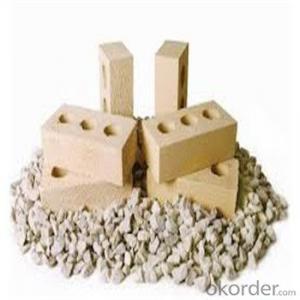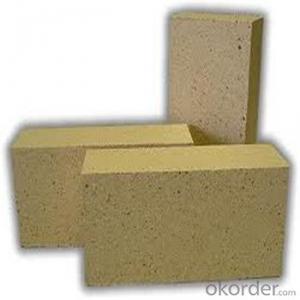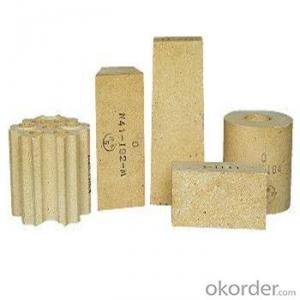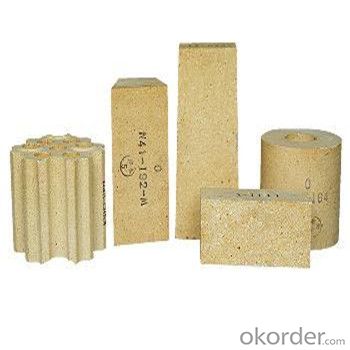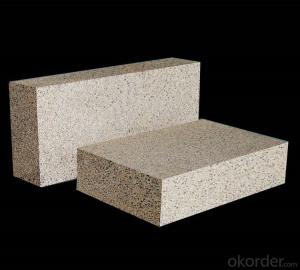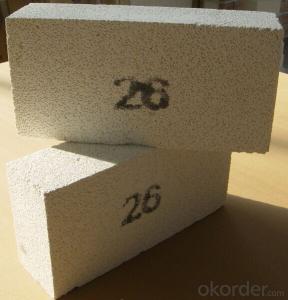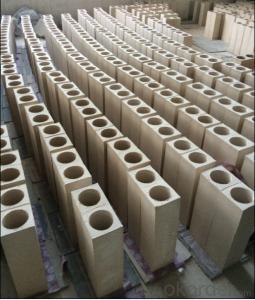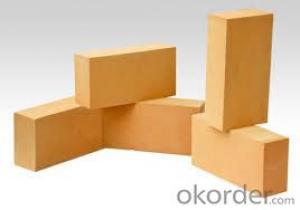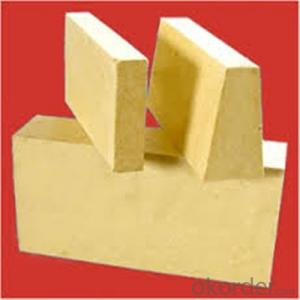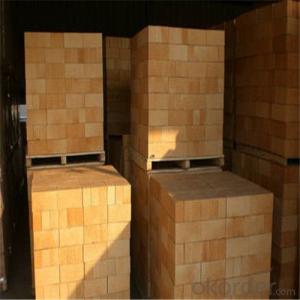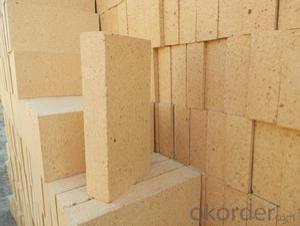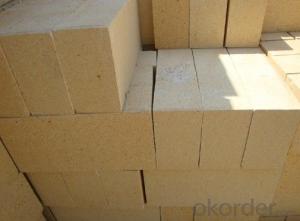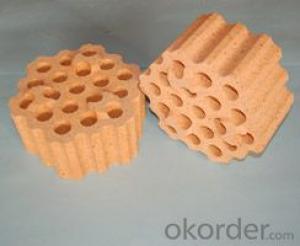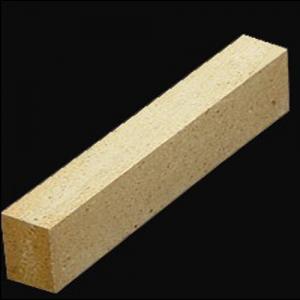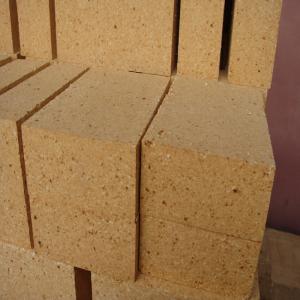Fireclay Brick - Low Creep for Hot Blast Stove
- Loading Port:
- China main port
- Payment Terms:
- TT OR LC
- Min Order Qty:
- 100 kg
- Supply Capability:
- 2000000 kg/month
OKorder Service Pledge
OKorder Financial Service
You Might Also Like
High alumina fireclay Brick
High alumina fireclay Brick for Heating Furnace is a kind of insulation material adopting organic matter as ignition loss substance in order to increase the porosity of refractory, which has such advantages as high porosity, small volume density, good insulation effect, high mechanical intensity, small thermal conductivity and long service life. For various industrial kilns & furnaces, it is a kind of essential refractory for energy saving and temperature preservation.
This series of High Alumina fireclay Brick for Heating Furnace are made of selected high alumina bauxite, kaolin caly, hollow microsphere as the mian material.By shaping at high pressure and sintering at high temperature.
Fireclay brick is shaped refractory product.It is made from flint clay clinker and binder , Through high heat sintering. The Al2O3 content range from 28% to 48%.The refractoriness range from 1580°C to 1750°C(SK-30.SK-32.SK-34.SK-35).
Product Applications:
High alumina fireclay Brick are ideal for use in the below applications
Furnaces of metallurgy industry, heat treatment furnace
Furnaces of chemical industry and construction industry.
Furnace of incineration of garbage, recirculating fluidized bed furnace
Standard sizing: 230 x 114 x 65 mm others up to the client
Product Advantages:
CNBM has success in its Fireclay brick due to their cost-effectiveness and excellent insulating properties. CNBM also has experience in ceramic fiber blankets application and would like to assist you in product selection, system design, and installation techniques.
Main Product Features:
High refractoriness,High-temperature endurable .
Good corrosion resistance.
Good spalling resistance and wear resistance.
Good thermal shock resistance.
High mechanical strength.
High-temperature creep rate is low.
Good volume stability at high temperature.
Product Specifications:
ITEM | UNF42 | UNF46 | ZGN42 | RN40 | TDL45-12 |
Refractoriness, ℃ | 1730 | 1750 | 1750 | 1730 | 1760 |
Bulk Density, g/cm3 | 2.15 | 2.25 | 2.3 | 2.15 | 2.37 |
Apparent Porosity, % | 22 | 20 | 15 | 24 | 12 |
C.C.S, Mpa | 30 | 35 | 58 | 28 | 68 |
Refractories Under Load (0.2Mpa),℃ | 1400 | 1420 | 1450 | 1430 | 1500 |
Reheating Linear Change, % | 1400℃x2h 0.1~-0.4 | 1430℃x2h 0~-0.1 | 1450℃x2h 0~-0.2 | 1350℃x2h 0~-0.3 | 1450℃x2h -0.1~+0.05 |
Al2O3 Content , % | 42 | 46 | 42 | 40 | 45 |
Size :
Common sizes
Straight type | Arch type | Wedge type |
L×W×H (mm) 230×114×65 230×114×75 230×114×32 220×110×60 220×110×50 220×110×40 220×110×30 | L×W×H/h (mm) 230×114×65/55 230×114×65/45 230×114×65/59 220×110×65/50 220×110×75/65 220×110×60/40 | L×W×H/h (mm) 230×114×65/55 230×114×65/45 220×110×75/65 220×110×60/40 |
Other sizes according to customer requirements | ||
FAQ:
Q1: How about your factory’s annual production capacity?
A1:CMAX annual production is about 310,000Tons.
Q2: How many production lines of your factory?
A2:CMAX has 26 production lines, including eight silicon bricks lines, and each one of mullite brick, high alumina brick, insulating brick and monolithics line.
Q3:How large the scale of your factory?
A3: CMAX covers almost 200,000 Square meters, including plant area of 180,000 square meters.
Q4: What’s your factory’s product scope?
A4:CMAX main products are: refractory for hot blast stove, refractory for coke oven, refractory for glass kiln, refractory for carbon calcining furnace, refractory for acid pickling line, refractory for cement kiln, refractory for blast furnace, refractory for nonferrous metal furnace, and basic refractory raw materials.
Product Picture
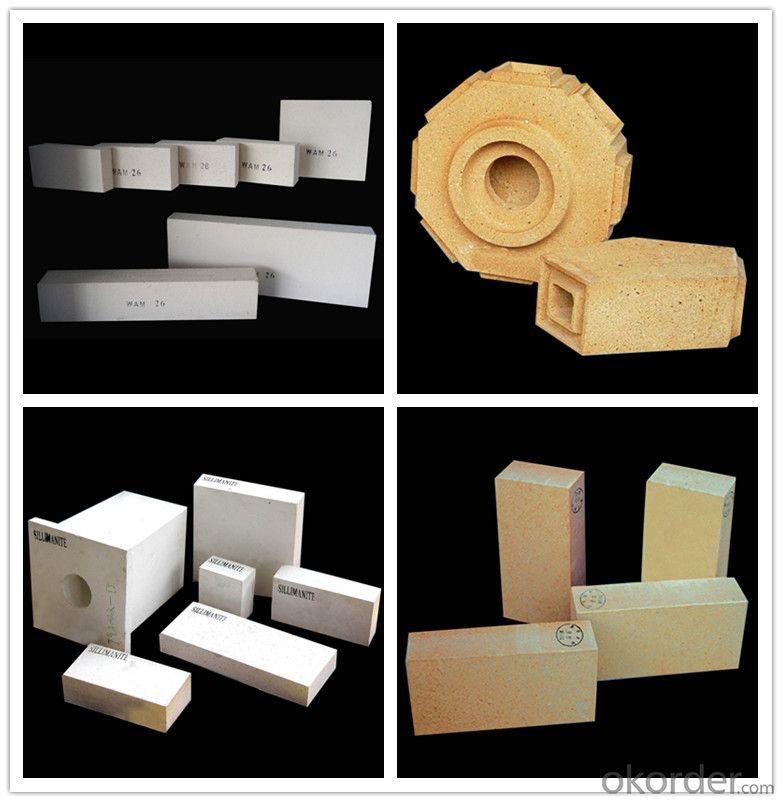
Produce Processing
Crushing
In this stage massive raw materials which have been stored, are ground and classified into proper sizes, making them easier to shape.
Mixing
The prescribed size of ground raw material is weighed and mixed into a designated amount of water and forming agent.
Shaping
The mixture is then poured into a mold to form shapes, and the pressure is high.
Drying
In this stage water is removed from the shaped bricks. This helps preventing the bricks from deforming or cracking which may result due to the rapid evaporation
Firing
This is the most crucial process in refractory manufacturing. The modeled bricks are fired at high temperature to complete their thermochemical reaction so that they do not deform.
Inspection
The bricks' physical and chemical properties are inspected very carefully by rigid quality management procedures.
Packing shipment
We guarantee efficient delivery every time.
Packing
We also supply (Click on following picture if interested):
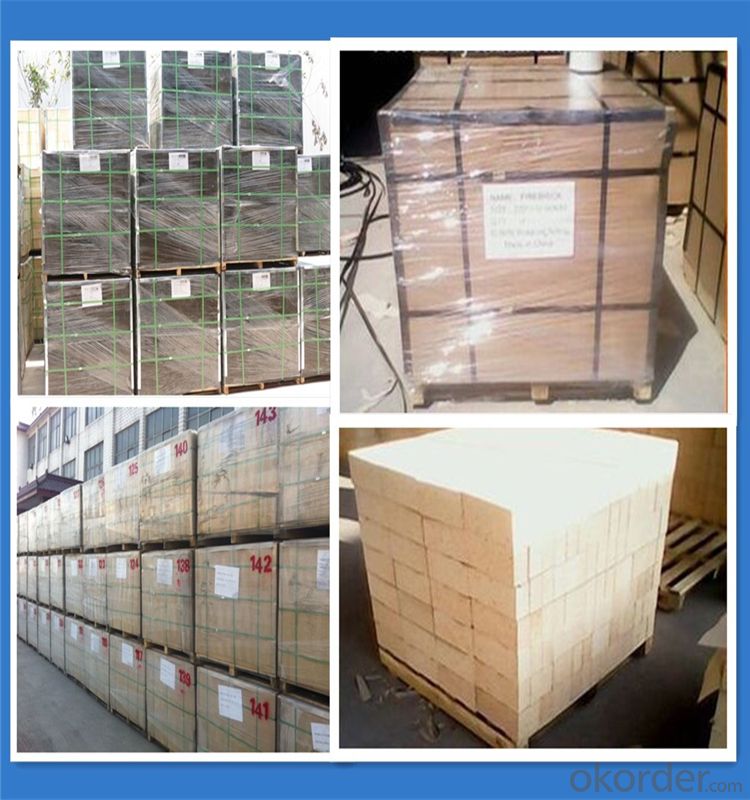
- Q: What's the reason of cracks in refractory bricks?
- If it is made to refractory bricks,dry in the air naturally for 10 days, then put into the drying furnace, which is certainly better than the brick is put to the furnace directly, this is not easy to crack. After all, the moisture of brick will run in the air. See the semi-finished products (not crack is really no crack), but after drying, it has cracks, this is must because moisture runs quickly in a short time. If it cracks after high temperature heat treatment, the reason is very complicated, such as after high temperature burning, temperature decreases too fast, resulting in a large temperature change, then it cracks. Or in the process of high temperature heat treatment, the internal reaction is intense, and generate some volume expanding materials, resulting in cracks and so on. Mullite Petrochemical reaction, spinel reaction and so on, the reactions of a lot of materials are the volume expansion
- Q: Lining of refractory bricks in rotary furnace
- The lining of the converter is probably a furnace, but if it is changed at least to see the material and the use of it. There are a lot of damage to the lining, such as: The total impurity content reduces to 2%, lining life will increase 20%-40%; CAO in brick is of 60%-80% content , lining life are the highest; also some other proper index can not be ignored such as bulk density,heat/thermal shock resistant performance,porosity,thermal expansion,fracture resistace,volume stability,Slag resistance,and so on. In addition, lining erosion rate is the largest when the basicity of slag is 1, with the increase of basicity, erosion rate decrease rapidly, the temperature can cause cracks spalling of lining. At the same time, the building process is also very important.
- Q: Where the refractory bricks rider bricks that are used for building arch and vault should be put?
- Arch and vault shall be built simultaneously from both sides of the arch of the foot to the center of symmetry, when masonry, inverting concentric reducer of arch brick is prohibited; the lock should be driven into the brick arch from the side, if the last rider brick can't be driven from the side, you can process the first 1-2 brick to make the size of the lock and the lock buckle equal, and then drive suitable rider brick from top, and use steel plate to jam-pack the side; dismantling arch tire must be performed after all rider bricks are driven and lock brick arch foot ditch masonry is completed and the final tightening nut for skeleton retractor rear.
- Q: What is the refractory temperature of refractory bricks?
- First look at the used parts of refractory brick, anti stripping performance, these are the most basic performance factors, the refractory temperature of high alumina brick is 1770 -1790 degree, the refractory temperature of clay brick is 1380-1570 DEG C, record the anti acid corrosion data of refractory bricks, the compressive strength of refractory bricks, at the same time, you should analyze each part of the furnace pH index and sintering temperature of working. When purchasing refractory bricks, you need to pay attention to many factors, high temperature creep property, softening temperature under a fixed load, 6548, volume stability at high temperature. Because the production of the product is affected by the weather and fuel energy, etc.. 186, select the suitable refractory bricks
- Q: Will the heat be taken away by the refractory brick
- No, refractory bricks can't be burnouted
- Q: What is common brick, firebrick and hollow brick?
- Mainly used for smelting furnace and silica brick. There won't be problem by using scientific methods. Refractory brick----is refractory material with a certain shape and size. According to the preparation process, can be divided into firing brick. Similarly. Hollow bricks are very scientific in use. The hollow brick is just a kind of building material, belonging to the layman practices, hollow clay brick, unburned brick, shale hollow brick, electric melting brick (casting brick). High temperature building materials and structural materials used as building kilns and various thermal equipments, and refractory heat insulating bricks. Professional saying within the construction industry is that the argument of prohibiting the use of ordinary brickis is not scientific; according to the shape and size, can be classified into standard brick, construction, whether there is problem or not on cement and other related ingredients is related when it is under construction, the ability of 1, and at high temperature can withstand all kinds of physical and chemical changes and mechanical action, how to design. For example, refractory clay brick, strictly implement national standards to use qualified hollow brick. 8 earthquake, high alumina brick , magnesia brick, etc. due to the security risks. Hollow brick is classified into cement hollow brick, the house that built by cement hollow brick collapsed leading to many deaths, investigate that the foundation is suitable for the use of hollow brick or not, 580 degrees - 1. Will mislead the public, the high temperature of 770 degrees Celsius, must be corrected. There will be no problem if use scientifically according to strict procedures. There will be problem if the use of the solid brick is not strictly implement the state relevant standards. Also called refractory brick, special-shaped brick and etc. Refractory material made from refractory clay or other refractory raw materials
- Q: How many squares of a ton refractory bricks?
- About 2 tons , general one square clay brick is about 2 tons, from 2, one square corundum brick or magnesia bricks can reach 3 tons, it should say one square is how many tons. if it is high aluminum, then see the content of aluminum. It mainly sees what refractory bricks, because the volume and density of refractory bricks are relatively large.2 tons to 2
- Q: what is application of high alumina refractory brick?
- reverberatory?furnace 1, close to the neutral refractory, but because mullite crystallization has not formed the network organization, so the load softening temperature is not higher than silica?brick. the refractoriness of high alumina brick is higher than fireclay?brick and semi-silica brick, mainly used in blast furnace, nozzle brick,etc. it is up to 1790 C~ 1750, can resistance to acid slag and alkaline slag erosion. hot blast furnace, blast furnace, high alumina brick are widely used for producing open-hearth?furnace regenerative bricks, because it contains SiO2, low impurity content, which belongs to high-grade refractory materials, electric furnace. 2, plug head used in pouring system . In addition. 3, because high aluminum products contains more Al2O3, forming less fusible vitreous body, so the high load softening temperature is higher than clay brick. because rotary kiln lining, slag resistance of high alumina refractory brick contain more Al2O3, so the ability of anti alkaline slag is weaker than anti acid slag. so it has a wide range of application. high alumina refractory brick due to the following performances
- Q: How good is the hardness of corundum refractory brick?
- The basic materials of corundum refractories are fused corundum or sintered corundum. the refractory brick containing more than 90% of Al2O3 is called corundum refractory brick. so, corundum refractory brick. Corundum has a high hardness (9 level of Mohs hardness) such as zirconium corundum refractory brick. Corundum refractory brick is resistant to acid well and melting point is also high, also known as pure alumina refractory brick products, , it has a good effect. These are closely related with the structure of the Al - 0 key, titanium corundum refractory brick, and other basic slag. It is used in high temperature oxidizing atmosphere or in reducing atmosphere. the metal and glass solution have good stability. a-Al2O3 is the main material of high temperature refractory brick and high temperature electrical insulating material .
- Q: What material does tile tunnel kiln use to replace the refractory brick to have better insulation effect and save the maintenance and prolong the service life?
- You can use ceramic fiber module
Send your message to us
Fireclay Brick - Low Creep for Hot Blast Stove
- Loading Port:
- China main port
- Payment Terms:
- TT OR LC
- Min Order Qty:
- 100 kg
- Supply Capability:
- 2000000 kg/month
OKorder Service Pledge
OKorder Financial Service
Similar products
Hot products
Hot Searches
Related keywords
